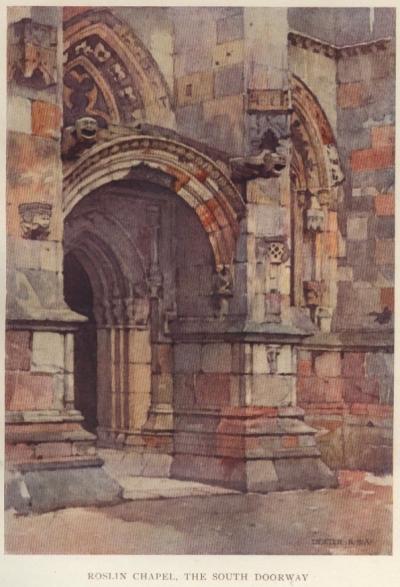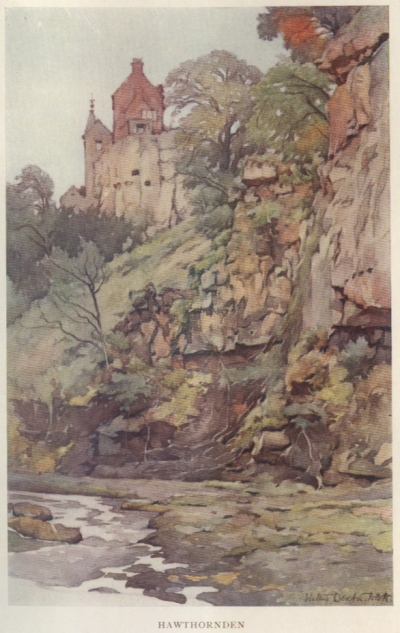|
| |
|
Edinburgh
and The Lothians
Chapter XXI - Roslin and Hawthornden |
|
ONE of the impressions the stranger takes away from
Edinburgh is the line of cars in Princes Street ticketed for Roslin and
Hawthornden. They are worth doing, and you pass many places of interest on
your way. The Bore Stone, where the Scots army assembled for that fatal
march to Flodden; Fairmilehead with its legend of the flute-playing gauger,
"haunted Woodhouselee," the locus of a quite baseless legend
regarding the Regent Moray, are some of them. You move along on the slopes
of the Pentlands, the greatest of all the near Edinburgh ranges. Another
route, quite unconventional but I fear impossible, would be to descend on
Roslin by the Esk. Now there are two Lothian Esks: the South Esk, which
rises among the Moorfoot hills, and the North Esk, which begins in the
Pentlands. These join at Dalkeith and reach the sea at Mussel-burgh. The
North Esk is one of the storied rivers of Scotland. Allan Ramsay knew its
beginnings well, and the scenery of its upper reaches is figured in his
charming pastoral of The Gentle Shepherd. Contending innkeepers or
antiquaries will make this or that spot "Habbie’s Howe," but you will more
wisely allow it to remain dubious. Roslin and Hawtbornden are the gems of
the Esk. The village will not detain you, though the old inn has memories
of Dr Johnson and Boswell, who drank tea there in 1773 and Robert Burns
later on was so well treated that he wrote some highly complimentary
verses to the landlady. The castle is a charming ruin, though the vaults
are the only very old part. When its stone mass piled on that rocky crag
above the stream bums red in the evening sunset you will swear no castle
of the Rhine ever looked so fair. Here for centuries ruled "the lordly
line of High St Clair." Earls of Caithness they were, but their power and
splendour were princely. My Lord was attended by I don’t know how many
noblemen, and his spouse by I don’t know how many ladies of high degree.
They were served on vessels of gold and silver. There are all sorts of
legends relating to the family. Scott, in the ballad of Rosabelle,
has prettily woven some of them together, and even added a new one. But
the story that most takes our fancy is one rather grotesque and farcical.
In 1447 St Clair of Dryden, which is close at hand, repaired to Roslin to
go a-hunting with his chief. He met an enormous crowd of rats speeding
along in their best style, among them one very old, very grey and very
blind, assisted by its companions, in its mouth a straw, the true intent
whereof is not revealed by the legend. There is a scornful phrase of
Bacon’s as to the "wisdom of rats, that will leave a house some time ere
it fall." Four days later the mansion of St Clair’s blazed in red ruin,
the result of an accident. But as yet fire insurance was not in the land
and My Lord had to put up with his loss. Only one thing disturbed him,
however. The family muniments, and some precious manuscripts of a more
private nature—perhaps poems, perhaps not—seemed gone for ever, but these
he presently had safe and sound. The chaplain, a man of infinite resource,
had secured the papers spite the raging flames. Both he and they were
singed, but the bell-rope fixed to a convenient beam afforded the means of
escape. You pass to Roslin Chapel, a gem of the very first water. It was
founded in 1446 by William St Clair, the Lord just referred to. He meant
it for a collegiate church, but only the chancel was built. The
magnificent fragments are only part of a grander plan, the dream is always
greater than the fact! It is strangely and beautifully decorated in
pillars and arches, with sumptuous rare carvings, a very garden of stone
flowers, the poetry of sacred architecture. The Lord of Roslin was himself
a man of taste, and he brought artists from far and near, and lavishly
entertained and rewarded them. And the incitement of his own zeal, and his
own precept was, you believe, more to the artists than the gold he
showered on them.

There is no settled plan. Each Master within proper
limits gives scope to his peculiar genius, and the result is this root out
of a dry ground, this strange exotic flower among those cold northern
fields, fit shrine for the most gorgeous rites of the old faith! You
wonder it survived the fierce turmoil of ancient Scots life. What a mere
shell is the chapel at Holyrood; what a mere shell is Sweetheart Abbey! In
1688 a raging mob from Edinburgh, memory of their wrongs strong
upon them, spoiled and defaced it in every way, and so it remained until
1868, when it was decently restored for the service
of the Scots Episcopal church. Its legends are manifold. The Apprentice
Pillar, in which the scholar exceeded the master, is found not only here,
but the chapel has traditions all its own. Here the
St Clairs were buried for centuries, each in
complete armour, and as portent the chapel glowed with magic fire as each
baron lay a-dying. But you remember how well those things are touched off
by Scott. And Scott must again be our guide :—
"Who knows not Melville’s beachy grove,
And Roslin’s rocky glen,
Dalkeith, which all the virtues love,
And classic Hawthornden."
If the chapel is a gem of art the glen is a gem of
nature. A brawling stream rushes over a rocky bed, between richly-wooded
and often precipitous banks. All this is to say little. It is a compendium
or epitome of Highland scenery. The path is so rough and winding as to
give you almost the sensation of peril, and there
are caves and gnarled tree trunks, and—but you will see
it for yourself, or, at any rate, description is inadequate. It is
a considerable walk, the better part of an hour, I think. At length, in
the depth of it, you come upon Hawthornden, perched on a high rock like a
very eagle’s nest, the waters swirling round it at such a rate that it is
positively sublime. There are the remains of an old fortress, with a
fairly modem seventeenth-century house and such additions as to-day’s
luxury demands. In far-off times it was held by the Abernethys, but the
Drummonds, who trace some marriage connection with the Abernethys, have
had it between three and four centuries. But if for so long there has
always been a Drummond of Hawthornden, there is one special Drummond
(1585-1649) whom we all know by name at any rate—the
Cavalier Poet, the friend, and in 1618 the host of rare Ben
Jonson. Rare and strange indeed that massive figure must have seemed among
those lean, meagre Scots!
You still get bits of Drummond in anthologies. First of
Scots he wrote entirely in English verse: Tears on the Death of
Moeliades, Forth Feasting, The Cypress Grove. You guess
the nature of the Cavalier Poet from the very names
of his works, as also from the epitaph he wrote for himself. He rests in
Lasswade churchyard some two miles off.
"Here Damon lies, whose song did
sometimes grace
The wandering Esk; may roses shade the place."
You still read him with pleasure. There is a courtly,
tender grace about him, a subdued echo of the Elizabethans. You must not
place him too high. Shakespeare stands alone, but you would not venture to
compare Drummond with the other great dramatists, say Ben Jonson
or Marlowe. He ranks with the men who are soldiers and statesmen first and
only in an idle or softer hour carved some delicate gem of poetry, with
Sir Philip Sidney or Sir Walter Raleigh.

You rise to the level of the house through delightful
terraced gardens, and there are sights galore: the cavern in the rock
which Drummond used as a study—. he had been more comfortable in the
house—the sycamore tree or its descendant under which he was seated when
rare old Ben hove in sight and they exchanged greetings in metre. And you
may also view the mighty sword which Bruce never wielded, and the pulpit
from which Knox never preached, and the deep cavern where the Drummond of
the day did not hide Queen Mary. So you are inclined to affirm, for
you grow weary of the insistent presence of those stock figures—tiresome
repeating decimals you might call them—in the traditions of every famous
Scots mansion. The extensive assortment of caverns under the house, even
though stripped of their quaint names and quaint legends, is sufficiently
curious. There seems ground for believing that Sir Alexander Ramsay of
Dalhousie and his merry men here found a retreat and hiding-place in those
far-off troubled days when Bruce and Balliol strove for the crown. You
will prefer to their musty depths the walk on the terrace by the sundial
for you are out in the bright air, and you see the house and the river far
below you, and the rocks and part of the glen. And a gentle envy possesses
you of the particular Drummond then in possession. What more blessed lot
than to sit down in that delightful house among those choice scenes, with
the memory of that long line of your forebears ever present, with pious
hope that your line will never fade, and there look round on portraits of
the great Masters of your country’s destiny and believe that your poet was
worthy to be ranked with them?
Lasswade I have already mentioned. Here Scott brought
his young bride and spent some of the happiest times of his life, and here
De Quincey abode for some seventeen years; and you may still see the
houses, or at least the outside of them, for "not shown" is surely with
sufficient excuse written on what was once Sir Walter’s. If you get
further down to Dalkeith you will find a very good example of an old Scots
town: fairly antique houses, and wynds and gardens behind; and in its huge
park there is a huge Palace containing things rare and beautiful, and here
the Dukes of Buccleuch held sway. Surely you are more than satisfied with
the things you have seen, and for the day, you will admit, sufficient are
the pleasures thereof! |
Return to
Edinburgh and The Lothians index page
|

